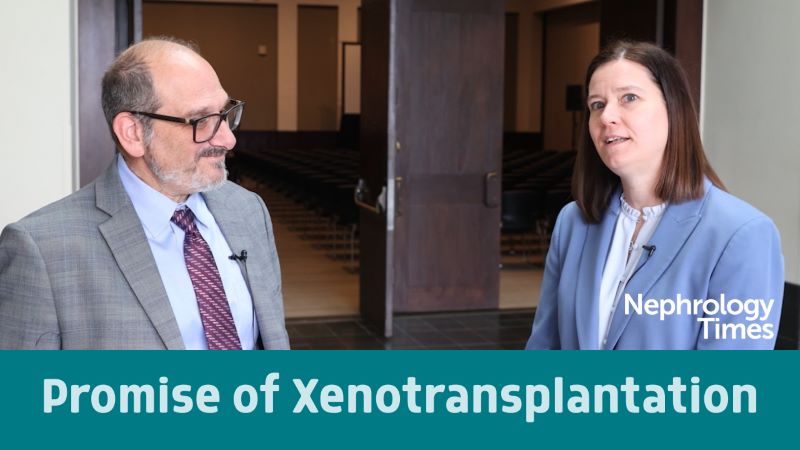GLP-1 Agonists Benefit Kidney Transplant Recipients With T2D
By Babak J. Orandi, MD, PhD, Charlotte Robinson - Last Updated: March 19, 2025Previous research suggested that glucagon-like peptide-1 (GLP-1) agonists, such as semaglutide, liraglutide, and dulaglutide, had benefits for recipients of kidney transplants with a history of type 2 diabetes. Yet the question remained whether clinicians should prescribe the drugs to transplant recipients because of their association with inflammation of the pancreas and liver problems and the potential for an increased risk of a rare form of thyroid cancer.
A recent study published in The Lancet Diabetes and Endocrinology reviewed the medical records of 18,016 kidney transplant recipients with pretransplant diabetes and found that those who were prescribed GLP-1 agonists, mostly within 3 years of receiving a transplant, were 49% less likely to experience organ failure and had a 31% reduced risk of dying within 5 years of starting the medication. In addition, they did not have a higher risk for inflammation in the pancreas, liver problems, or thyroid cancer, although they did have an increased risk of developing diabetic retinopathy.
Study co-author Babak J. Orandi, MD, PhD, of the New York University (NYU) Grossman School of Medicine spoke with Nephrology Times about the study and its findings.
What differentiates this study population from those in other GLP-1 agonist trials?
There are a lot of differences between the kidney transplant population and patients that are in clinical trials. In general, we often see that clinical trial patients are not fully representative of the population that the data are meant to be extracted to. But particularly with transplant recipients, they tend to have more severe forms of disease.
So, for example, in our study we looked at patients with diabetes—and those are patients who really have the end-stage results of diabetes, meaning they had kidney failure from it and so their diseases tend to be more severe. They tend to have a lot of other comorbid conditions. They’re on long-term immunosuppression, and they’re at risk for a number of other things—other events that might happen that are also associated with GLP-1 receptor agonists, like pancreatitis. And so, we don’t really know for sure what the data look like in this population based on clinical trials that are currently out there.
How common is the use of GLP-1 agonists in transplantation?
Another great question. We don’t really know there. It looks to be increasing over time. The data that we looked at is a couple of years dated because we don’t have sort of real-time data, but it looks like maybe 10% to 15% of patients who are eligible for these medications are taking them. But you know, I anticipate that as we get more experience with these medications in transplant populations, [and] we have more data, I think people will be more comfortable, when appropriate, to use these medications.
Could you give an overview of the effectiveness results?
We looked at graft survival and mortality in this study. The outcomes that we often look at in the clinical trials are things like degree of weight loss and improvements in hemoglobin A1C. We didn’t have those data to study. So, we couldn’t look at those outcomes.
But we looked at outcomes that I think are arguably more important, which are graft survival and patient survival. Those are sort of, you know, we think about hemoglobin A1C and weight loss, and those are all sort of intermediate steps between starting the drug and the hard outcome of losing your kidney transplant or dying. And what we found was that the patients who received [a] GLP-1 receptor agonist had a 49% lower risk of death-censored graft loss, and they had a 31% lower mortality risk.
When we first looked at the results of the study, we were really impressed by how dramatic the improvements were in graft and patient survival. And so, we really dug into it, really deeply tried to do a number of sensitivity analyses to make sure that these numbers that we were seeing were real and not just a statistical artifact or some study design flaw. But over and over again, no matter how we looked at it, the data appeared pretty consistent across a number of different analyses.
And so, while we don’t have clinical trial data for this, the post–kidney transplant population, I know that for me this certainly enhances or reinforces what I do in my practice. And hopefully, we’ll give others the data they need to move forward in helping patients access these medications that they might be beneficial for.
Could you discuss the safety findings? Were they surprising?
Sure. We found that patients who were started on these medications had a 49% higher likelihood of developing diabetic retinopathy. I don’t think this is terribly surprising, but I think it’s really helpful information to know. It’s because patients who’ve had end-stage kidney disease because of diabetes have more severe diabetes, oftentimes harder-to-control diabetes, and so we expect them to have more advanced disease.
I don’t think that the development of diabetic retinopathy is a class effect of this drug. We see the precipitation of diabetic retinopathy in patients who are started on insulin. If they have poorly controlled diabetes that is corrected too quickly, we see that happen. And so, I think that it’s a statement really about how effective these drugs are and that we just have to be a little bit more careful when we use them.
What should the next steps be for the study or use of GLP-1 agonists with transplantation?
Well, we have some data that are under review right now looking at the pretransplant population. So, I think that’s going to be an important aspect to know. I think we need more long-term follow-up data. It certainly doesn’t hold me back in my practice of prescribing these medications for patients who’ve had a transplant because I feel that the results and the effects that we see clinically are pretty significant, and those benefits outweigh the risks.
But I would like to understand mechanistically why these drugs work so well. It’s not just weight loss. It’s not just improvement of diabetes based on other studies that are out there that these medications have some other effects. And I think understanding that better would be really helpful for our sort of greater understanding of how to help patients who have had a transplant and are trying to improve their long-term graft survival and long-term survival. And it’s a pretty important topic because 1 in 5 patients with diabetes who get a deceased donor kidney transplant will be dead in 5 years, and that number is 1 in 8 for patients who get a living donor kidney transplant. And so, their long-term survival—really, we have a lot of work to do to try to make that better.






 © 2025 Mashup Media, LLC, a Formedics Property. All Rights Reserved.
© 2025 Mashup Media, LLC, a Formedics Property. All Rights Reserved.